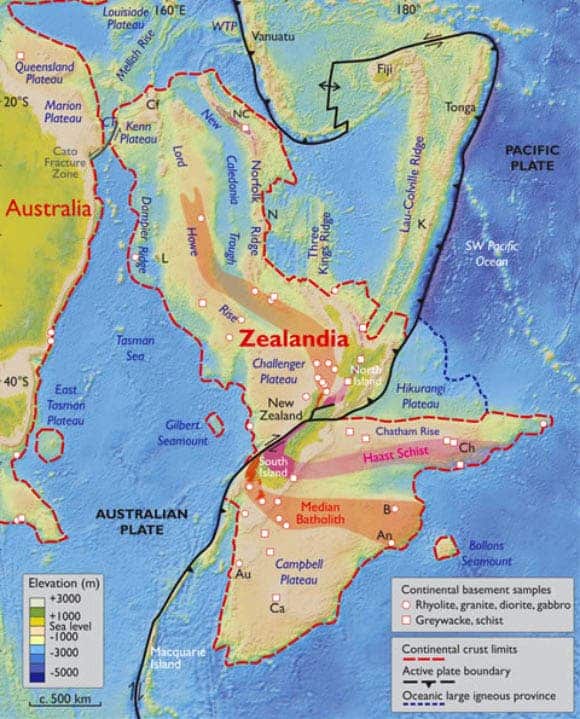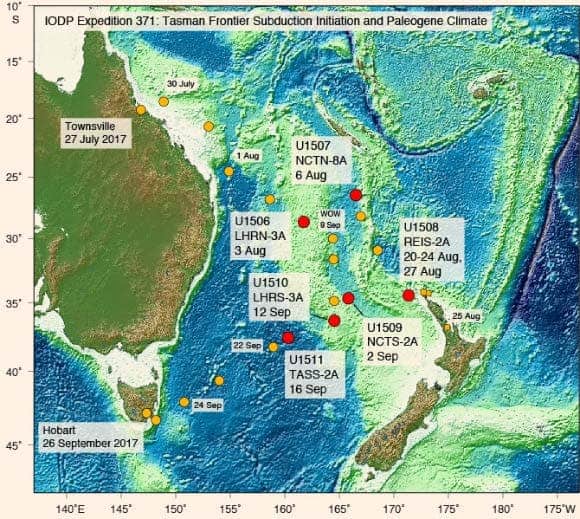
In 2017, geologists made a convincing case that Earth has, in fact, eight continents if you also include Zealandia. Although it is mostly beneath the ocean, with the exception of New Zealand and New Caledonia, Zealandia is mostly made of continental crust rather than the magnesium- and iron-rich ocean crust. For this reason, many believe Zealandia qualifies as a continent.
Now, in a new study, researchers have revealed how the long-lost undersea continent evolved since its formation. In the process, they found that Zealandia’s upheaval may have been responsible for the birth of the Pacific Ring of Fire.
Forging the Ring of Fire
A new continent in the 21st century? Did it just pop overnight? “This is not a sudden discovery, but a gradual realization,” wrote 11 geologists who authored a 2017 paper published in GSA Today, recommending that ‘Zealandia’ be considered a continent.
The researchers claim that New Zealand and New Caledonia aren’t just some islands chains — they’re just 5 percent of what’s visible above the ocean’s surface, the rest of the 5-million-square-kilometer continent is submerged underwater. That makes Zealandia about as big as greater India. It would also be the ‘youngest, thinnest, and most submerged’ of the continents,’ according to the authors of the 2017 study.
Zealandia itself isn’t something new. It was coined by one of the authors of the 2017 paper, Bruce Luyendyk, a geophysicist at the University of California at Santa Barbara, back in 1995. However, originally, Zealandia was used to describe New Zealand, New Caledonia, and a collection of submerged pieces and slices of crust that broke off a region of Gondwana, the supercontinent from 200 million years ago.
“If we could pull the plug on the oceans, it would be clear to everybody that we have mountain chains and a big, high-standing continent,” said Nick Mortimer, a geologist at GNS Science.
Yet, we still know very little about the submerged continent. But a new study suggests that the story Zealandia is even more amazing than meets the eye.
An international team of researchers recovered sediments from drilling beneath the ocean floor during a 2017 expedition, then sent them to the lab for analysis. Some of the sediments below the Tasman Sea were laid down as long ago as 100 million years ago.
The entire expedition lasted nine weeks and involved 32 scientists from all over the world onboard the research vessel JOIDES Resolution. This wasn’t a walk in the park, though — the researchers had to drill as a deep as 5 km (3.1 miles) using a drill that weighed 300 tonnes.
Encased inside the sediments are tiny fossils, which the researchers used in order to determine the elevation of the sediments when they were deposited. This way, the researchers hoped, they might be able to find out why Zealandia is so different from all the other continents.

Three sites in the northern region of the continent had the kind of fossils that indicated a shallow reef ecosystem between 35 million and 50 million years ago. Perhaps, some of the areas were terrestrial during that time. Today, these sites are found smack in the middle of the Tasman Sea, close to the Lord Howe Rise deep-sea plateau.
Close to the New Caledonia Trough, the fossils contained plankton species known to inhabit deeper waters. This indicates that the elevation of Zealandia had dropped in the 35- to 50-million-year time frame.
The authors of the new study suspect that after northern Zealandia rose and the New Caledonia Trough subsided, the entire continent sunk another 1 km beneath the sea.
Since the 1970s, the prevailing theory of Zealandia’s formation claimed that its low profile is due to the thinning of its crust after it separated from the supercontinent Gondwana about 85 million years ago. However, these latest findings presented by the expedition of scientists show that portions of the Zealandia rose by 1-2 km while others subsided about the same amount.
Rupert Sutherland, geophysicist at Te Herenga Waka-Victoria University of Wellington and co-author of the new study, claims that this topographic upheaval may be due to the reactivation of ancient faults linked to the formation of the Pacific Ring of Fire — a region known for its relatively frequent earthquakes and volcanic activity
“Although subduction drives Earth’s plate tectonic cycle, scientists don’t yet understand how it starts,” Dr. Sutherland said.
“One of the amazing things about our observations is that they reveal the early signs of the Ring of Fire were almost simultaneous throughout the western Pacific,” he added.
“Because this timing predates the global tectonic plate reorganization, scientists need to find an explanation for how subduction began across such a broad area in such a short time.”
Sutherland and colleagues have proposed a radical new mechanism that explains these observations: a ‘subduction rupture event’ — a massive but super-slow earthquake, in the researchers’ words. This geological event essentially resurrected ancient subduction faults that had laid dormant for millions of years.
“We don’t know where or why, but something happened that locally induced movement, and when the fault started to slip, like in an earthquake the motion rapidly spread sideways onto adjacent parts of the fault system and then around the western Pacific,” Dr. Sutherland said.
“But unlike an earthquake, the subduction rupture event may have taken more than a million years to unfold.”
Although the ‘subduction rupture event’ is still a new theory, the evidence so far suggests that such events can quite possibly alter the geography of continents. What’s more, the same events that triggered changes in Zealandia may have to the formation of the Ring of Fire subduction zones around the western Pacific.
“Ultimately, Zealandia’s sedimentary record should help us determine how and why this event happened and what the consequences were for animals, plants, and global climate,” Dr. Sutherland said.
“The process has no modern analogue and because the subduction rupture event is linked to a time of rapid, global plate tectonic change, other instances of such change in the geologic record may imply that comparable events have occurred in the past,” Dr. Sutherland said.
“Geologists generally assume that understanding the present is the key to understanding the past. But at least in this instance, this may not hold.”
The findings appeared in the journal Geology.


